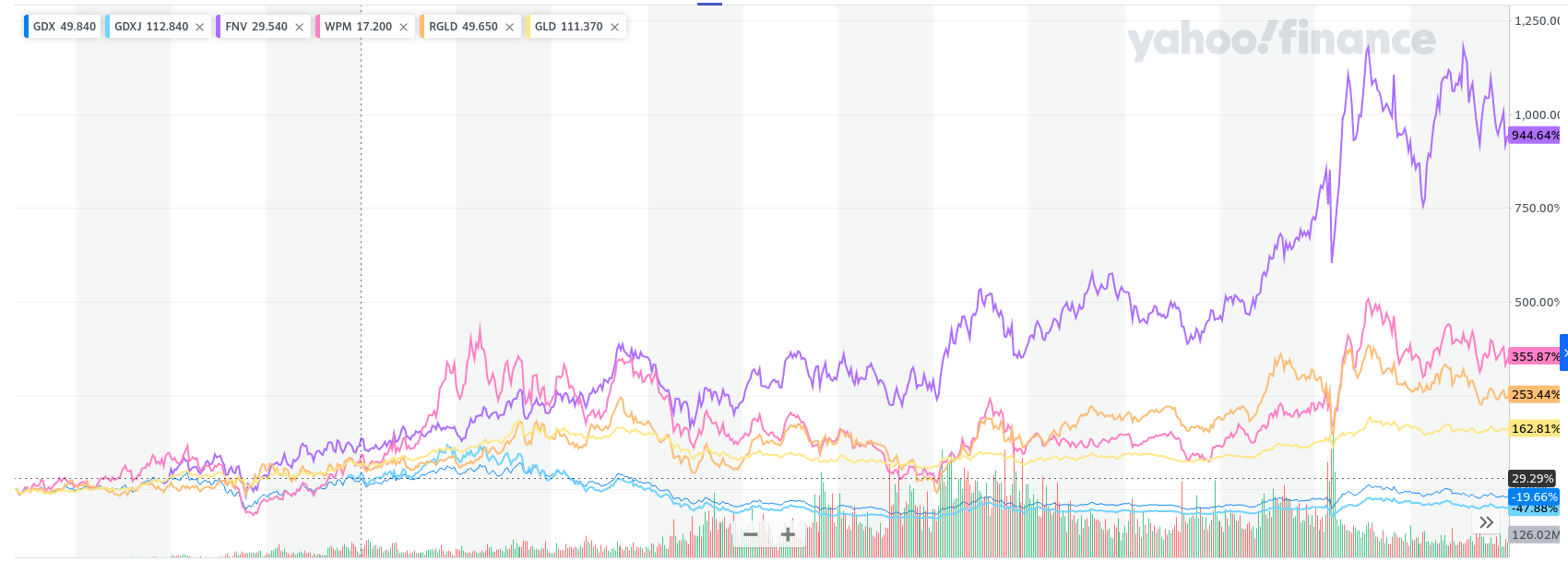How To Not Lose Your Shirt Investing In Mining
I've said for awhile that this isn't an industry you can passively invest in through an index. You will lose your shirt.
So, how do you not lose your shirt? What strategies have strong evidence of working?
Buy Royalty Companies

I popped open Yahoo Finance and opened a chart for $GDX , the index of larger gold miners, and set the timeframe to max. I then threw on a comparison of $GDXJ (the smaller gold miners), $GLD (a physical gold etf), and the three oldest royalty companies $FNV, $WPM, and $RGLD. Let's see how they did over this timeframe:
| Ticker | Return |
|---|---|
| $FNV | +944% |
| $WPM | +355% |
| $RGLD | +253% |
| $GLD | +162% |
| $GDX | -19% |
| $GDXJ | -48% |
You can pick pretty much any rolling 5 year timeframe with physical gold prices up or down and a basket of the royalty companies will outperform the physical metal which will outperform the big miners which will outperform the small miners. I even saw someone backtest a pair trade long a basket of royalties, short the $GDXJ and the steadiness of the returns was shockingly good.
Why Does It Work
- Royalty companies have lower costs of capital than miners
- Royalties aren't diluated when new shares are issued or debt is raised
- Royalty companies income go down relatively less with low metal prices
- Royalty companies benefit from mill expansions but don't pay for them
- Royalty companies benefit from exploration but don't pay for it
Buy Pre-Production Sweet Spot
Louis James aka Lobo Tigre of the Independent Speculator Newsletter lays this out most clearly in his Pre-Production Sweet Spot study. He's not the first to notice this upward trend in this part of the Lassonde Curve, but we'll adopt his terminology because I think he lays this out with the most convincing amount of data.
The methodology is pretty simple. Buy at Construction Decision. Sell at either First Pour or declaration of Commercial Production. The average returns are over 100% in an average of 1.5 years, but you need to spread your bets out because over 20% of them deliver negative returns. Focusing on 50,000+ oz mines improves your odds a little.
Kevin MacLean, former gold stock fund manager and current chief investment officer for Star Royalties, calls this the risk transition yield.
The second one is risk transition yield that's the phrase that i give to that gain in a stocks price as it de-risks from developing an asset into operating an asset and that could be substantial. I'll give you a i'll talk about that in the developer sector section
uh so the market discounts uh that asset typically to about 17%, not the not the five percent that's going to be there when it's in production but 17% that's an empirical observation i just made over many years back calculating what stocks are trading for because i've had these debates with analysts as a portfolio manager well Kevin used to be buying the stock it's cheap as chips and I'd say we'll back calculate the IRR and this thing says well it's 17%, 18% I said well that's about right so it's going nowhere.
now but here's the math if you have a 10-year mine life that's trading at a 17% discount rate instead of 5% it's trading at 0.6 times NAV. If you're going to go from point six times NAV to 1.0 times NAV that's a two-thirds return 66%, and you can get that in the last six to nine months, sometimes sometimes longer but you know in the last six nine months most of that you can pick up if the mine operates properly starts up properly so you can get a massive return and i did have a number of those names in my portfolio. I'm not averse to holding them but i i would generally enter them – I'd let the financing for the project build go by and let a year go by maybe and then start looking at it.
Why Does It Work
- You are paid for the risk of failure
- Certain Investors Only Invest in cashflowing assets
- The market is often backwards looking
Buy Prospect Generators
Rick Rule transcript starting at 2:22 in the following video:
I have done this with some very certain success over the last thirty years. I have been involved by my count in something like 55 prospect generators. I have participated in 22 economic discoveries and been the beneficiary of 15 takeovers. If you think about the concept of 15 major wins in 55 starts and compare that statistically with any other type of means of discriminating between exploration investments the payoff from prospect generator joint venture business model portfolio over any other kind is unassailably better.
Why Does It Work
- Prospect Generators benefit from other people's spending
- Prospect Generators get access to a large number of projects and returns to exploration are a power law with a small number of very large winners.
- The success rate is still under 50%, so you are getting paid to take on the risk.
Updates:
Feb 4, Added Kevin MacLean's talk on risk transition to Pre Production Sweet Spot.